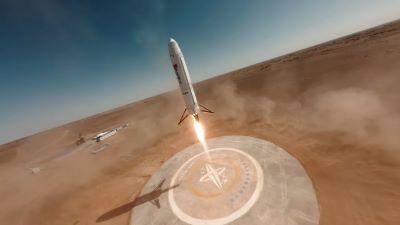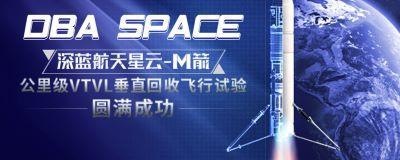Fri, Sep 27, 2024
Rocket Damaged After Partial Failure in Landing
Deep Blue Aerospace’s Nebula-1 rocket executed its first High-Altitude Vertical Recovery Flight Test on September 22. It successfully completed 10 out of 11 objectives, experiencing a damaging anomaly during the final landing stage.

The test began at 05:40 UTC at the Chinese commercial rocket firm’s Ejin Banner Spaceport in North China's Inner Mongolia Autonomous Region. The Nebula-1 launched with three out of nine engines ignited, then shut down two more to rely on the thrust of a single engine. After stabilizing and moving around 200 meters to the side, the landing legs were deployed and locked. During the final landing phase, however, an unusual shutdown led to the rocket dropping from a much higher altitude than anticipated.
Drone footage from the 179-second flight shows the Nebula-1’s fall, causing significant damage to the bottom section of the vessel. Still, Deep Blue Aerospace commented that several notable accomplishments were made during the test. The Nebula-1 completed 10 objectives from the test outline without error, even landing with less than half a meter of error on the recovery site.
A preliminary retrospective analysis of the test data shows that the engine thrust servo “followed the control command abnormally,” the company stated, forcing the rocket to land before its design range. The company is slated to host a new VTVL test in November.

The Nebula-1 is Deep Blue Aerospace's first commercial liquid rocket capable of entering orbit. It is intended to be reused after landing, marking a significant milestone for the company’s recyclable technology. The rocket has a 3.35-meter body diameter and a 21-meter first-stage height, with more than 90% of the structure formed using a high-temperature, 3D-printed alloy. It utilizes nine Thunder-R liquid oxygen-kerosene engines and is China's first reusable liquid rocket engine developed independently by Deep Blue Aerospace.
The Nebula-1 completed its kilometer-level VTVL test in May 2022. This was the first time that the Thunder-R engine was seen in action.
Deep Blue Aerospace is now in the process of designing a Nebula-2 rocket. This will be larger than the Nebula-1 design and will be capable of hosting a 20,000-kilogram payload.
More News
Outboard Section Of The Right Wing And The Right Flap Separated In Flight And The Airplane Impacted A Farm Field Analysis: The pilot was approaching his destination airport under i>[...]
Final Approach Fix The fix from which the final approach (IFR) to an airport is executed and which identifies the beginning of the final approach segment. It is designated on Gover>[...]
"Our choice of when to respond, how to respond and on which targets to respond is a consideration that we make every time... Netanyahu also noted that anyone attacking Israel &ldqu>[...]
Estimated (EST) When used in NOTAMs “EST” is a contraction that is used by the issuing authority only when the condition is expected to return to service prior to the e>[...]
Aero Linx: Coalition of Airline Pilots Associations (CAPA) The Coalition of Airline Pilots Associations (CAPA) is the world’s largest pilot trade association representing ove>[...]
 NTSB Final Report: Cessna 177B
NTSB Final Report: Cessna 177B ANN's Daily Aero-Term (05.08.25): Final Approach Fix
ANN's Daily Aero-Term (05.08.25): Final Approach Fix Aero-News: Quote of the Day (05.08.25)
Aero-News: Quote of the Day (05.08.25) ANN's Daily Aero-Term (05.09.25): Estimated (EST)
ANN's Daily Aero-Term (05.09.25): Estimated (EST) ANN's Daily Aero-Linx (05.09.25)
ANN's Daily Aero-Linx (05.09.25)




